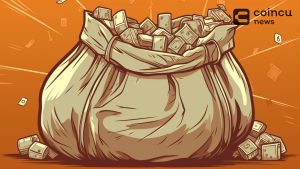The NFT hype shows no signs of cooling down from the involvement of Coinbase and FTX
The NFT and the markets it is traded in are growing extraordinarily fast and have been a focal point in the crypto space for some time. Even at the height of the bull cycle, the hype surrounding the NFT hasn’t let up. It can be said that the traction gained is at an all-time high and is climbing even higher.
According to one report from DappRadar, the NFT industry generated $ 10.67 billion in trading volume in the third quarter of this year, an increase of 704% over the second quarter. In addition, the Ethereum and Ronin blockchain networks account for 77.73% and 19.53% of the volume, respectively.
Compared to the previous year, this year’s Q3 trading volume increased by 38,060%, an exceptionally high value given the growth in the industry.
Monthly NFT trading volume | Source: Dappradar
To capitalize on this growth, most of the major exchanges have started digging into the space with the promise of creating inexpensive, efficient markets for these digital assets. The FTX exchange launched its US-based NFT marketplace in September, which was shortly expanded to include tokens from the Solana ecosystem.
Binance launched the NFT platform in June of this year to give customers access to the “exploding NFT space”. Following these announcements, the major US exchange Coinbase has entered the market with its own NFT marketplace, which will launch later this year. The marketplace will allow users to mint, buy, discover, and recommend a wide variety of Ethereum-based tokens. Creators will take control of their artwork with decentralized contracts and metadata transparency since all of the NFTs are in the chain.
This announcement caused a stir in the community. Coinbase has opened a waiting list for the market that has over 1 million registered users on day one. At the time of writing, the waiting list has grown to 2.43 million users, which has caused the monthly users of OpenSea, the largest market by trading volume, to plummet.
Alex Salnikov, co-founder and product manager at Rarible, an NFT marketplace, said:
“Large companies are starting their own NFT platforms as they realize that digital collections are rapidly emerging as a new creative avenue that is reaching a wide audience that they couldn’t reach before, especially now that NFT is more attractive.”
Alex Salnikov also mentioned that in addition to the monetary benefits for creators and businesses in the NFT industry, this space can be seen as an opportunity to unleash creativity and expression in new ways that were not possible before. Even one of the leading blockchain networks, Ripple, has announced a $ 250 million fund for NFT creators focused on accelerating NFT adoption in the crypto space.
Despite the current hype and mainstream media attention, even a small fraction of the world’s population knows about NFT, and when these larger companies get involved, they will serve the industry by building awareness and pushing for mainstream adoption.
When such large companies venture into emerging markets as NFTs and collectibles, it is often a calculated risk. Pavel Bains, CEO of Bluzelle, a decentralized storage network for creative people, says:
“Each of these large companies knows their customers well and the target market is evolving. For them, the smart thing is to be one step ahead of the curve. If it’s too early, it won’t hurt your budget much. ”
The market can be pretty saturated
A closer look at this month’s numbers on the NFT market reveals another interesting finding. SuperRare, an Ethereum-based NFT marketplace, set a new monthly trading record of $ 35.88 million in October this year.
This reflects that the market can be quite saturated when an investor has a bigger slice of the pie. Another metric reflects a similar trend for whales in NFT markets and platforms. Moonstream, an open source blockchain analytics company, has announced 21, which found that the top 16.71% of addresses owned nearly 81% of NFTs based on the Ethereum network in the second and third quarters of this year.
The monthly trading volume of Opensea | Source: Dune Analytics
However, Salnikov thinks this could be a good sign:
“This seems to correspond to the 80-20 rule, also known as the Pareto principle, and is hardly different from traditional markets, where 80% of the results come from 20% of all causes. Given that the NFT market is still in its infancy, this finding really shows that it is maturing. ”
Bains points out that this metric is part of a larger phenomenon:
“The same can be said about BTC right now. The buyers were probably half of the buyers who were there shortly before the Coinbase IPO. This is how cryptocurrencies work. I don’t think it will change the macro trend of cryptocurrencies and NFTs. ”
While it is clear that Bitcoin is a much more mature asset than the NFT when compared to traditional financial markets, it is still in its infancy. Sakinov believes the industry is only just beginning to touch the surface of what the NFT has to offer. With the growth of digital collections, more and more platforms are becoming aware of use cases that warrant a surge in demand for NFTs beyond their collectible nature.
Innovations like play-to-earn help NFT grow
Until recently, the most talked about NFTs were unique collections like CryptoPunks or collections based on and supported by celebrities. However, aside from the boastful rights to be used as JPEG avatars and their potential future secondary market value, they are very limited in their usefulness.
Bains is generally skeptical about celebrity collections:
“Celebrity collections will fail at some point. Although it initially attracted fans and gradually began to resemble physical celebrity collections. However, there will not be as much demand and appreciation as there will be for crypto-native raw materials. ”
He added that there is a lot of evidence that crypto has its own culture and wants products to emerge from it.
In addition to providing ownership of cryptocurrency collections to users, blockchain-based game protocols with a play-to-earn (P2E) model such as Axie Infinity, CryptoBlades and Mobox are gaining traction. Despite its success, this model faces some challenges from the traditional gaming community.
Leighton Emmons, co-founder of the NFT Blockchain Boys Club project, was skeptical of the P2E phenomenon and called these games a fad:
“Online games are so rich that anyone who plays online games goes through a period of obsession until they completely neglect a game – at some point you get bored and want a new experience. No one is going to build financial stability from a game given the number of hours it takes to participate. The concept feels a bit like an interesting novelty. ”
Emmons also believes the P2E concept is a bubble in itself:
“What happens when the NFT is sold out and the player has provided all available funds (aka coins)? Will advertising and sponsorship be enough to cover operating costs beyond the in-game rewards? ”
With or without P2E games, the NFT industry is growing at a tremendous rate and attracting all blockchain players. Even Vitalik Buterin, the co-founder of Ethereum, mentioned NFT in a recent podcast interview where he talked about how NFT is attracting new users to the crypto space:
“NFTs are interesting from a cultural point of view because they bring people to Ethereum, for example a completely different mindset from DeFi and normal crypto users.”
With NFT currently growing rapidly on networks other than Ethereum, adoption is likely to continue to grow for the foreseeable future as bigger players in the industry now begin to bet on it.
Join Bitcoin Magazine Telegram to keep track of news and comment on this article: https://t.me/coincunews
Mr. Teacher
According to Cointelegraph
Follow the Youtube Channel | Subscribe to telegram channel | Follow the Facebook page




















